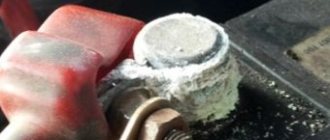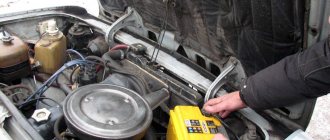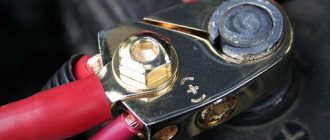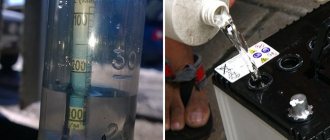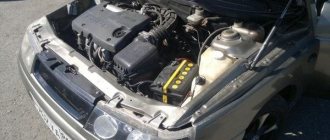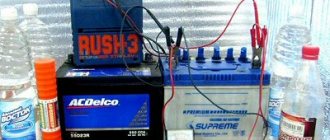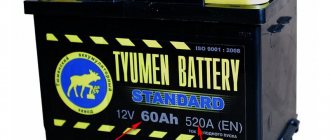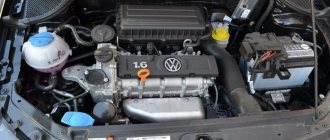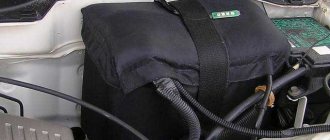Safety precautions
If you want to remove the battery yourself, you should not forget about basic safety precautions. Absolutely forbidden:
- Throw the device on the ground or allow it to fall into the open hood.
- Turn the knot over with sharp movements.
- Press firmly on the terminals and try to place them on the terminals.
- Completely pouring the liquid out of the battery will lead to unpleasant consequences in the form of sediment that has accumulated at the bottom for a long time floating up, as well as clogging of the holes.
- Use force when dismantling or reinstalling the system.
- Work with a discharged device in cold conditions, at sub-zero temperatures.
- Add electrolyte or any acid to the battery yourself. The only liquid that can be added is distillate.
When dismantling, it is enough to use two wrenches of the appropriate size. You also need to take a rag or brush to thoroughly clean the interior from dirt.
If at any stage an electrolyte spill occurs, it will be necessary to apply a neutralizer to prevent the reaction from activating.
When working with an acid battery, it is necessary to prepare the alkali in advance. To do this, you can use a solution of 10 percent alcohol or soda. Alkaline batteries are treated with acid. It is recommended to carry out such actions outdoors or in a well-ventilated garage.
Compliance with the basic rules of battery maintenance will allow you to restore a non-functioning unit in a short time and without much effort. If you know how to open the Varta battery with your own hands, then the need to contact a service center for help will automatically disappear.
How to open the varta battery cover
The German company Varta was founded in 1887 and since then has been producing and repairing all types of batteries. Currently, the German company Varta is rightfully considered a leader in the production of rechargeable batteries of all types. The batteries are manufactured in 6 factories in 5 European countries.
Varta car batteries produced are used by European car manufacturers for installation in new cars. More than 20 million Varta batteries are produced per year, which in foreign currency equivalent amounts to more than half a billion euros.
Varta is an abbreviation (Vertrieb, Aufladung, Reparatur Transportable Akkumulator) - in other words Sales, Charging, Repair of Transportable Akkumulator.
Advantages of VARTA batteries
- Since 2002, the South American company Johnson Controls has been creating Varta starter batteries.
- Does not require topping up water during the entire service life (completely maintenance-free).
- Greater operational safety due to the labyrinth design of the lid.
- The Silver Dynamic series batteries have a 30% increased starting current.
VARTA SILVER DYNAMIC – the greatest power for the greatest demands.
The top product of the dynamic TRIO series impresses with its internal features: reliable power supply with a very large number of power consumers, very high cold start performance even in extreme conditions and the largest reserve capacity. The power properties exceed the requirements of international car manufacturers.
Advantages of SILVER dynamic
VARTA BLUE DYNAMIC is a powerful all-rounder.
Removing the battery cover
How to remove the cover from a maintenance-free battery? With a serviceable battery, everything is clear - to access the electrolyte, you just need to have a screwdriver on hand with which you can unscrew the plugs.
If the battery has a single cover, then you will need a screwdriver with which you can remove the cover. However, there are rechargeable batteries, the removal of the cover - strip on which will lead to failure of the battery. Next, we will consider the question of how to remove the top battery cover on the most popular models.
The contents of any car battery are enclosed in a housing. Serviced batteries are distinguished by the ability to gain access to the banks and, if necessary, add electrolyte or distilled water. The maintenance-free closed-type battery is characterized by a smooth surface of the housing. To avoid any contamination, the upper part of the battery is retracted under the cover.
Serviceable batteries have plugs for checking the cans. Getting to the contents of a maintenance-free battery is more difficult. There are no plugs, and the monolithic lid is a labyrinth for trapping and condensing vapors. Disruption of the labyrinth's passages will reduce the efficiency of the system. Therefore, before opening the battery cover, you need to weigh the pros and cons.
Here are some options for how to get to the electrolyte:
- The battery has a peephole with a float. By prying off the glass, we gain access to one battery bank. Measuring the density of the electrolyte in one jar does not give a complete picture.
- Remove the battery cover. The top part is cut off or torn off by force as it is soldered. After servicing the battery, the main difficulty is to glue the cover in place. This method should be avoided if possible.
- Drilling holes is the most accessible way to open a battery.
The best method is to drill holes. For most procedures this is enough; you can pour electrolyte through them and check its level and density.
- The centers must line up with the castings for the factory filler plugs. By removing the stickers, the outlines are easily visible.
- It is better to drill in several stages so that chips do not get inside. The first drill is 3-4 mm. After drilling all the holes, you can use a thin dipstick to check the electrolyte level. If this is the end of the test, small holes can be filled with hot glue or silicone.
- The second drill is 12 mm. Through such a hole you can use a hydrometer.
To plug the holes, you can use plastic stoppers from medicines - motherwort, peppermint, valerian. The plugs should become tight; they need to be prepared before drilling. When installing, the plugs can be placed on glue, then with a high degree of probability the properties of the labyrinth lid will be preserved.
How to charge the battery
Charge the battery according to the following recommendations:
- After a car battery is discharged, it must be charged as soon as possible in order to prevent the possibility of its failure;
- Place in a well-ventilated area, as hazardous gases will be released during charging;
- If possible, we try to determine whether there is water in the jars, since if it is absent, then during the charging process the plates will crumble and the battery will become unusable;
- Using a multimeter, we determine whether the battery is alive, it should be
12.4 volts;
- Wipe the battery, as it may be wet and the terminals will begin to short-circuit with each other;
- You need to charge with a current not exceeding 10% of the battery capacity, that is, no more than 6 Amperes;
- First, we connect the plus of the charger to the plus of the battery, and then the minus to the minus, so that sparks do not occur.
- We turn on the charger to the network.
- After the battery is charged, depending on the charger used, the corresponding light should light up. (see instructions for your charger).
- Disconnect from the network;
- We remove the terminals.
It is best to use smart chargers with an automatic shut-off function and the ability to adjust the voltage level.
If, during charging, electrolyte begins to be released, the case becomes very hot, or an unpleasant odor appears, then you should immediately disconnect it from the charger.
Subtleties of autopsy
If the task is to maintain a closed battery, it must be done taking into account several subtleties.
When a motorist wants to remove lead from a non-working unit (for example, for hunting or fishing), there is no need to be afraid of breaking the body with a hammer or any other object, but before doing this, you must first drain the acid solution. If you want to extend the service life of the battery, you need to carefully make holes that will provide access to containers with electrolyte. The following steps should be followed step by step:
- Remove stickers from the surface of the case.
- Carefully inspect the structure. Given the tightness of the lead-acid model, it should retain the factory stampings of the plugs.
- Using an awl, drill or any other tool, make small holes in the desired location.
This procedure is not considered difficult, but it must be treated with special responsibility. Under no circumstances should you miss the basic rules, otherwise this will lead to unpleasant consequences.
Step by step guide
There are many reasons why motorists become interested in how to remove the cover from a Varta battery. If there is a need to perform such an action, you need to remember that each stage may have its own difficulties. To avoid disappointment in the future, it is better to study the working nuances in advance.
We recommend: Titan Arctic: high-quality titan car batteries
Before disconnecting the car battery, you must review the service manual in detail. Some modern machines are equipped with a special lever that turns off the unit. There may also be a shield with a toggle switch on the body. To quickly and efficiently disable the device, it is important to read the manufacturer's manual. By the way, there are also cars that do not support disconnecting the battery. Instead, they require parallel installation of a new part to replace the old one.
To avoid sparks jumping during dismantling, it is better to install a special fuse on the vehicle. It is mounted at the output, with a negative charge. As at all other stages, it is important to be careful and attentive here, since any mechanical damage can break the seal, and the crack formed will become a place for the leakage of a liquid substance - electrolyte.
Maintenance free models
It is no secret that many car batteries cannot be refurbished due to their design features. For motorists who do not want to constantly think about the current state of the power source, this option looks attractive. However, most domestic drivers are accustomed to independently monitoring their car and servicing it in the garage.
If you want to dismantle the battery and restore its functionality, it is enough to use certain tricks and tools.
All internal components of the power supply are housed in a durable housing. If we talk about serviced models, they have open access to containers with liquid electrolyte, so the technician can easily take them out, add acid and carry out a number of other activities.
As for maintenance-free devices, they are equipped with a smooth surface, and the entire upper part is located directly under the cover, which protects it from technical contamination. This design can be removable with latches, or monolithic. In the latter case, it is welded to the body by heat welding. Closed batteries often have monocaps.
To open a maintenance-free unit, you need to prepare several tools. If the cover fastening is located on the grooves, it is enough to carefully unclip the fasteners and dismantle the element. You may need to use a flathead screwdriver for this task.
If the assembly is hot pressed, it will not be easy to remove. Any careless actions can lead to damage to the part, so it is better not to dismantle this element in order to maintain its integrity. But if this is not possible, and removal is necessary, it is carried out using a screwdriver, drill or awl. It will not be possible to completely remove the cover, but it is quite possible to make several holes for further work.
Important points
After dismantling the battery, you need to pay attention to the condition of the wire terminals and the unit itself. Often these parts oxidize, becoming covered with a white coating. If such a defect is present, it is enough to treat the surface of the battery with sandpaper. It is also necessary to inspect the seat of the device.
If there are various technical contaminants in it, you need to go through it with a scraper or brush.
At any stage of dismantling, it is important to remember safety rules. Under no circumstances should you smoke near the battery, light matches or a lighter, or come into contact with an open flame source. Such an impact can cause damage to the unit, and in the worst case, ignition of vapors from leaked acid.
We recommend: Labeling batteries for cars
If there is a serial number, model name and other technical characteristics on the battery cover, it is recommended to photograph them or write them down on a sheet. The fact is that this data can significantly simplify the upcoming purchase of a new battery.
Restoring a non-working part
It is no secret that productive and long-term operation of a battery significantly deteriorates its performance properties. As a result, after a certain period of time, the car owner is no longer satisfied with the performance of his vehicle. If your car has a sealed battery, there is no need to rush to throw it in the trash and buy a new unit. Knowing how to open a Varta d43, c15 or any other model battery, you can restore it in the near future.
First you need to dismantle the cover, following the established diagram. After this, access to the working components of the battery will be open, so any repair work will not take much time.
Closed battery models are equipped with an electrolyte level change indicator. Most modern devices have a translucent body or labels that provide free control of the solution flow in containers. To check the current level, you can use a regular tube, syringe or other object that is inserted inside the jar. The optimal volume of solution is 10−12 mm of substance above the plates.
It is important to take into account the fact that the electrolyte level and its density are the most important parameters of the normal condition of the battery. To determine the current characteristics, it is enough to use a hydrometer. You can also take a syringe, insert it into the hole and withdraw the acid from the container. Then you need to pour it into the device and track the readings. If the fluid density is too low, the battery will not be able to function fully.
Visual inspection and cleaning
External cleaning of the battery is necessary to maintain proper performance. Maintenance and cleaning of the battery should be carried out at the same time, except for those moments when the battery is too dirty. But 10 minutes is enough to wipe the battery with a damp cloth without removing it from the car.
During inspection, you must ensure that the battery case is intact, that there are no leaks of electrolyte, as well as traces of oil, antifreeze or antifreeze. After inspection, you can begin cleaning: thoroughly wipe the battery case with a damp cloth. It is better to use dry rags to wipe the terminals.
After wiping, the battery terminals should be lubricated with a special gel that prevents the appearance of an oxidative film and conductive deposits. If there is no gel, then simple grease or cyatim is quite suitable, which is used to lubricate the bearings of electric motors operating at high speeds.
Do I need to add water or electrolyte?
https://www.youtube.com/watch?v=6Wf3OCT6Uco
A battery hydrometer is required, without which battery maintenance is impossible. The device costs little and is suitable for checking the density of electrolyte and coolant (antifreeze or antifreeze). This parameter can be measured not only during a full battery service, but also just once every 2-3 weeks. To measure, you do not need to remove the battery from the car.
Sequence for measuring electrolyte density:
- Unscrew the plastic lids covering each jar.
- Lower the nozzle of the intake tube into the electrolyte until it comes into contact with the plate.
- Pump some electrolyte into the tube with a blower.
- Place the measuring hydrometer into the tube. The electrolyte level will be opposite the corresponding reading on the hydrometer.
Selection must be made from each jar.
A new, maintenance-free battery that works properly in your vehicle does not need to be opened or serviced. If it was subjected to a long recharge, turned over, or its performance dropped sharply - only then you need to think about either purchasing a new battery, or how to disassemble and restore the faulty battery.
When to service your battery:
- If it is visible to the light that there is less electrolyte in one jar.
- The voltage at the terminals is low and charging has no effect.
- The battery capacity has noticeably decreased.
- Electrolyte leaked due to damage to the housing.
- Carrying out restoration after battery sulfation.
